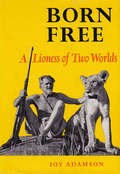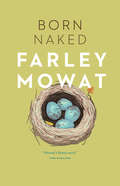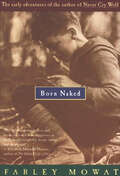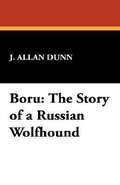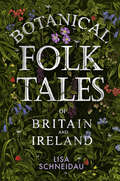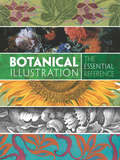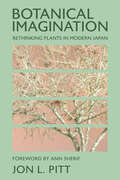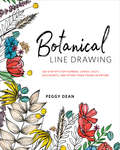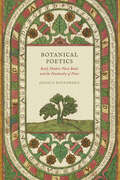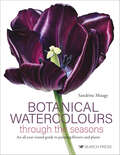- Table View
- List View
Boris Sees the Light: A Branches Book (Boris #4)
by Andrew JoynerFor even a brave warthog like Boris, the thrills of a backyard campout can turn into chills when nighttime falls . . . Boris is having a sleepover! He’s camping in the backyard with Frederick and Alice. And they are not one bit scared of the dark. No way! But what is that strange light moving around outside the tent? And what is making all of those strange, scary noises? It’s up to Boris to find out . . . This series is part of Scholastic’s early chapter book line called Branches, which is aimed at newly independent readers. With easy-to-read text, high-interest content, fast-paced plots, and illustrations on every page, these books will boost reading confidence and stamina. Branches books help readers grow!“Attractive, slyly humorous illustrations, simple text and a related craft included at the end all serve to make this a welcome addition to collections for beginning readers.” —Kirkus Reviews
Born Free
by Joy AdamsonThere have been many accounts of the return to the wild of tame animals, but since its original publication in 1960, when The New York Times hailed it as a “fascinating and remarkable book,” Born Free has stood alone in its power to move us. Joy Adamson's story of a lion cub in transition between the captivity in which she is raised and the fearsome wild to which she is returned captures the abilities of both humans and animals to cross the seemingly unbridgeable gap between their radically different worlds. Especially now, at a time when the sanctity of the wild and its inhabitants is increasingly threatened by human development and natural disaster, Adamson's remarkable tale is an idyll, and a model, to return to again and again.
Born Naked
by Farley MowatFarley Mowat's outrageous memoir begins with his unlikely conception in a canoe and continues to his boyhood fascination with creatures of the natural world and on to his youthful rambles and adventures. To his immense pleasure and his parents' dismay, he adopted various beasts (whom he affectionately calls "The Others") as roomates. In this boyhood memoir, he recounts the exploits of this second family, who have been the subjects of many of his beloved books for young readers. This is the tale of a mischievous, immensely gifted young naturalist, recounted with the wisdom, humour and grown-up perspective of a very talented writer.
Born Naked
by Farley MowatFarley Mowat's outrageous memoir begins with his unlikely conception in a canoe and continues to his boyhood fascination with creatures of the natural world and on to his youthful rambles and adventures. To his immense pleasure and his parents' dismay, he adopted various beasts (whom he affectionately calls "The Others") as roomates. In this boyhood memoir, he recounts the exploits of this second family, who have been the subjects of many of his beloved books for young readers. This is the tale of a mischievous, immensely gifted young naturalist, recounted with the wisdom, humour and grown-up perspective of a very talented writer.
Born Naked: The Early Adventures of the Author of Never Cry Wolf
by Farley MowatFarley Mowat's youth was charmed and hilarious, and unbelievably free in its access to unspoiled nature through bird-banding expeditions and overnight outings in the dead of winter. The author writes of sleeping in haystacks for survival, and other adventures, with equal shares of Booth Tarkington and Jack London. He also brings back Mutt, the famous hero-dog of his classic THE DOG WHO WOULDN'T BE, and his pet owl Wol, hero of OWLS IN THE FAMILY. The tale of an outrageous and clever boy, BORN NAKED takes its place as the foundation of the Farley Mowat canon.
Born at Midnight
by C. C. HunterSixteen-year-old Kylie Galen thinks her misbehaviour in the wake of her grandmother's death and her parents' separation are the reasons she has been sent to Shadow Falls Camp, but learns it is a training ground for vampires, werewolves, and other "freaky freaks," of which she may be one.
Born in the Year of Courage
by Emily CroffordIt is the mid-1800s and Manjiro, a young fisherman, is shipwrecked far off the coast of his native Japan. <p><p> At this time in history, Japan is an isolated country that allows its citizens no contact with the rest of the world. Foreigners are called "barbarians"—and none are more despised than Americans. But when Manjiro and his fishing companions are rescued by an American ship, Manjiro makes some startling discoveries about the world of the barbarians—and about his own country. <p><p> His dramatic rescue leads to a series of amazing escapades, and in the end Manjiro travels farther than he ever dreamed he would. Born in the Year of Courage is based on the true story of Manjiro's remarkable life. It is both an exciting adventure tale and a fascinating look at a bygone world.
Born of Fire and Rain: Journey into a Pacific Coastal Forest
by M. L. HerringGo beyond the scenery of the Pacific temperate rainforest to witness how complex ecosystems survive in a world of upheavals If you live on a rapidly changing planet, you&’d be wise to learn how it works. The giant old forests on a skinny stretch of land on the far west coast of North America have a lot to say about living in a twitchy world. In this engaging book science writer M. L. Herring takes readers into the Pacific temperate rainforest at the tumultuous edge of a shifting continent in a precarious moment of time. Readers peek behind the magnificent scenery into a forest of ancient trees, exploding mountains, disappearing owls, tsunamis, megafires, and ten million people to learn what it means to be a forest in a world of upheavals. Through Herring&’s words and pictures, readers drift into the canopy through masses of ferns and lichens, burrow into soil through hair-thin threads of fungi, and plunge headlong through a watershed flushed with rain and snowmelt. Readers experience the temperate rainforest through science and art as it faces a shifting climate and the shifting priorities of a constantly changing society. The book journeys beyond the grid of latitude and longitude and into places only one&’s imagination can fit, to discover what it means to be human in an ecological world.
Born to Be Wild
by Matt LondonHOW WILD WOULD IT TO BE TO BUILD ON AN EIGHTH CONTINENT?Rick and Evie Lane believe that the eighth continent will be theirs to rule forever. There's just one problem: global rule-maker Winterpole won't let anyone move there!Now, the Lane family must rush to create hospitals, homes, schools, and (shocker!) government buildings to prove that their continent is fit for human habitation. But the Lanes aren't the only ones engaged in this race for space. Condo Corp secret CEO Vesuvia Piffle recognizes this as her opportunity to finally snag the eighth continent for herself. If she can knock down enough of the Lanes' buildings and construct perfect, pink, plastic ones in her image, the eighth continent might just finally be hers to make all sugary sweet and spider-free.The Lanes will need to use every resource at their disposal to ensure that their precious eighth continent remains as natural--and wild--as they are. Just as it was born to be.BUILD IT - RUN IT - RULE IT at 8thContinentBooks.com
Born to Fish: How an Obsessed Angler Became the World's Greatest Striped Bass Fisherman
by Tim Gallagher Greg MyersonFrom RattleSinker inventor Grey Myerson, "an extraordinary story of one man's obsession, a tale of passion, brutality, tragedy, and redemption...a book about a love of fishing that tackles the deepest themes of life" (Helen Macdonald, author of H is for Hawk).Born to Fish tells the tale of a man who led a harrowing, sometimes dissolute life until he turned himself around, thanks to his rod and reel. Overcoming learning disabilities, substance abuse, and the violence associated with a father in the mob, Greg Myerson, a lifelong sport-fisherman, caught an 82-pound striped bass in 2011, shattering a world record that had stood for 29 years. Without any training in biological research, he began studying the striped bass like a scientist—examining how it hunts, the food it eats, how its behavior is affected by moon phases and the cycles of the tides—which led to the creation of the RattleSinker, the lure that helped him catch the record-setting bass. During an appearance on the TV show Shark Tank, Mark Cuban bought a 33 percent share of Greg's company, World Record Striper Company. Yet at the very instant he achieved his crowning glory as a striped bass fisherman, he had a staggering epiphany and instantly regretted killing the fish. Greg is now at the forefront of the effort to save the big striped bass, the most prolific breeders, and actively promotes no-kill catch-and-release tournaments.
Borne by the River: Canoeing the Delaware from Headwaters to Home
by Rick Van NoyAfter a near-fatal stroke and a separation, amidst a global pandemic, Rick Van Noy decided to go for a paddle. In Borne by the River, he charts the story of discovery, and healing that came from this solo canoe journey. Paddling two hundred miles on the Delaware River to his boyhood home just upriver from Trenton, New Jersey, Van Noy contemplates his fate and life, as well as the simple joy of sitting in a small boat floating down a large river with his dog, Sully.Deftly combining memoir, natural and local history, and engaging reportage of his encounters with other paddlers and river enthusiasts, including members of the Lenape Nation of Pennsylvania, Van Noy reveals deep and shifting layers of environmental, historical, cultural, and personal significance of the Delaware. Borne by the River reckons with the way that rivers braid into one's own life—thrilling rapids, eddying pauses, and life-changing rifts and falls. Van Noy rediscovers and shares how river journeys can scatter anxieties, wash away regrets, and recreate the spirit in its free-flowing currents.
Boru: The Story of an Irish Wolfhound (Famous Dog Stories)
by J. Allan DunnEscaping a circus, where he had been part of a dog act, the giant Irish Wolfhound ran wild, took as a mate a great white wolf, and became a freebooter, ranging the hills and plains of northwestern Montana. Based on a true story.
Boston: A Historic Walking Tour
by Anthony Mitchell SammarcoOliver Wendell Holmes coined the Massachusetts State House as the "Hub of the Universe." In Boston: A Historic Walking Tour, readers are guided on a series of downtown walking tours that radiate out from this Boston landmark. Featuring different excursions that explore Boston's prominent neighborhoods and districts, visitors and natives alike will see how this city has become one of the country's oldest cultural destinations. Boston's growth and development in the 19th and 20th centuries has contributed to it becoming the unofficial "Capital of New England"; its economic and cultural impact on the entire New England region is far reaching. Although Boston is known for its notoriously crooked streets and narrow alleys, it is a mecca for walkers looking to take in historic sites and surround themselves with history. Walk along Tremont, Washington, Beacon, and Summer Streets to explore downtown Boston. Saunter down Beacon Street on Beacon Hill and Boylston Street in the Back Bay to take in the city's most beloved sites.
Botanica: The Wichita Gardens
by Keith WondraGrowing from 4 gardens in 1987 to 29 in 2015, Botanica, The Wichita Gardens has become a regional attraction. The dream of a botanical garden in Wichita started in the early 1970s with John Firsching, superintendent of landscape and forestry with the Board of Park Commissioners, and in 1987 the gardens opened on the site of Wichita's Sim Park. Images of Modern America: Botanica, The Wichita Gardens tells the story of the people, events, and stories that have shaped Botanica into Wichita's garden. Included are images of Botanica throughout the gardens' 28-year history and the earlier history of Sim Park, many of which have never been published before.
Botanical Beauty: 80 Essential Recipes for Natural Spa Products
by Aubre AndrusSoak, scrub, and soothe your way to relaxation with simple homemade spa recipes from award-winning author Aubre Andrus. Using some of nature’s best ingredients, such as beeswax, sugar, coconut oil, shea butter, avocado, sea salt, essential oils, and more, craft everything from a Cooling Peppermint Hand Cream to a Vanilla Honey Body Scrub. Make practical products, like your own all-natural Bugs-Be-Gone Insect Repellent, Minty Homemade Toothpaste, and Natural Shaving Cream. Or pamper yourself after a long day with a Re-energizing Tub Tea, Lovely Lavender Bath Salts, and a Deep Conditioning Treatment. Nourish your body from head to toe with these organic, handmade recipes and crafts, or package them as a gift to share a fresh, fun spa experience.
Botanical Drawing: A Step-By-Step Guide to Drawing Flowers, Vegetables, Fruit and Other Plant Life
by Penny BrownThe definitive artist's guide to drawing detailed and accurate plants, flowers and other vegetation in pencil—including illustrations and exercises.Botanical Drawing provides a thorough and expert guide to the subject, touching on the history of this fascinating art form as well as its rules and practicalities. Artist Penny Brown explains the materials, learnings and techniques required to produce accurate botanical illustrations. She also includes an accessible, basic study of botany for the absolute beginner.By following Brown’s step-by-step instructions, close studies and explorations of the subjects, you will be able to produce your own illustrations of plants, flowers, vegetables and their myriad parts. Botanical Drawing offers knowledge, techniques, and inspiration as you create your own projects.
Botanical Folk Tales of Britain and Ireland
by Lisa SchneidauThe islands of Britain and Ireland hold a rich heritage of plant folklore and wisdom, from the magical yew tree to the bad-tempered dandelion. Here are traditional tales about the trees and plants that shape our landscapes and our lives through the seasons. They explore the complex relationship between people and plants, in lowlands and uplands, fields, bogs, moors, woodlands and towns. Suitable for all ages, this is an essential collection of stories for anyone interested in botany, the environment and our living heritage.
Botanical Illustration: The Essential Reference
by Carol Belanger GraftonComprising more than 500 years of printed botanical illustrations, this stunning compendium of black-and-white and color images begins with medieval illuminated manuscripts and woodcuts from the early days of printing. In addition to images from the fifteenth and sixteenth centuries, the collection features highlights from such seventeenth-century classics as Gerard's Herbal, Besler's Hortus Eystettensis, and Crispin van de Pass' Hortus Floridus. Latter-day selections include illustrations from major nineteenth-century works -- including the great flower prints of Pierre-Joseph Redouté and hand-colored lithographs by many other artists of the period -- as well as the imaginative twentieth-century floral work in the Art Nouveau style of M. P. Verneuil, E. A. Seguy, and others.Detailed bibliographical information concerning every source and biographical information on the artists make this volume a vital reference tool as well as a splendid resource of significant and beautiful botanical illustrations. Students of graphic art and illustration as well as graphic designers, advertising professionals, and horticulturalists will prize this treasury of material from many rare historic sources.
Botanical Imagination: Rethinking Plants in Modern Japan (The Environments of East Asia)
by Jon L. PittBotanical Imagination explores the complicated legacy and enduring lure of plant life in modern Japanese literature and media. Using critical plant studies, Jon L. Pitt examines an unlikely group of writers and filmmakers in modern Japan, finding in their works a desire to "become botanical" in both content and form. For nearly one hundred years, a botanical imagination grew in response to moments of crisis in Japan's modern history.Pitt shows how artists were inspired to seek out botanical knowledge in order to construct new forms of subjectivity and attempt to resist certain forms of state violence. As he follows plants through the tangled histories of imperialism and state control, Pitt also uncovers the ways plants were used in the same violence that drove artists to turn to the botanical as a model of resistance in the first place. Botanical Imagination calls on us to rethink plants as significant but ambivalent actors and to turn to the botanical realm as a site of potentiality.
Botanical Line Drawing: 200 Step-by-Step Flowers, Leaves, Cacti, Succulents, and Other Items Found in Nature
by Peggy DeanFrom the artist behind the popular Pigeon Letters website, an easy, no-skills-necessary guide to drawing flowers, leaves, and cacti with 200 step-by-step prompts.Line drawing is an easy-to-master art form featuring illustrative, doodle-like designs. It's used widely among artists of many types with both fine and bold lines, creating different variations. Botanical Line Drawing teaches you how to start with the simplest doodles, building into more elaborate, delicate illustrations. This book focuses on the extremely popular subject matter of the natural world and includes flowers, leaves, succulents, houseplants, trees, branches, mushrooms, and more. These simple line drawings will allow you to branch out and have fun with your own personal style, as well as inspire you to add flourishes to other projects.
Botanical Poetics: Early Modern Plant Books and the Husbandry of Print
by Jessica RosenbergDuring the middle years of Queen Elizabeth’s reign, the number of books published with titles that described themselves as flowers, gardens, or forests more than tripled. During those same years, English printers turned out scores of instructional manuals on gardening and husbandry, retailing useful knowledge to a growing class of literate landowners and pleasure gardeners. Both trends, Jessica Rosenberg shows, reflected a distinctive style of early modern plant-thinking, one that understood both plants and poems as composites of small pieces—slips or seeds to be recirculated by readers and planters.Botanical Poetics brings together studies of ecology, science, literary form, and the material text to explore how these developments transformed early modern conceptions of nature, poetic language, and the printed book. Drawing on little-studied titles in horticulture and popular print alongside poetry by Shakespeare, Spenser, and others, Rosenberg reveals how early modern print used a botanical idiom to anticipate histories of its own reading and reception, whether through replanting, uprooting, or fantasies of common property and proliferation. While our conventional narratives of English literary culture in this period see reading as an increasingly private practice, and literary production as more and more of an authorial domain, Botanical Poetics uncovers an alternate tradition: of commonplaces and common ground, of slips of herbs and poetry circulated, shared, and multiplied.
Botanical Shakespeare: An Illustrated Compendium of all the Flowers, Fruits, Herbs, Trees, Seeds, and Grasses Cited by the World's Greatest Playwright
by Gerit QuealyA captivating, beautifully illustrated, one-of-a-kind color compendium of the flowers, fruits, herbs, trees, seeds, and grasses cited in the works of the world’s greatest playwright, William Shakespeare, accompanied by their companion quotes from all of his plays and poems. With a foreword by Dame Helen Mirren—the first foreword she has ever contributed.In this striking compilation, Shakespeare historian Gerit Quealy and respected Japanese artist Sumié Hasegawa combine their knowledge and skill in this first and only book that examines every plant that appears in the works of Shakespeare.Botanical Shakespeare opens with a brief look at the Bard’s relationship to the plants mentioned in his works—a diversity that illuminates his knowledge of the science of botany, as well as the colloquy, revealing his unmatched skill for creating metaphorical connections and interweaving substantive philosophy. At the heart of the book are "portraits" of the over 170 flowers, fruits, grains, grasses, trees, herbs, seeds and vegetables that Shakespeare mentions in his plays and poems. Botanical Shakespeare features a gorgeous color illustration of each, giving a "face" to the name, alongside the specific text in which it appears and the character(s) who utter the lines in which it is mentioned.This fascinating visual compendium also includes a dictionary describing each plant—such as Eglantine, a wild rose with a slight prickle, cherished for its singular scent, superior to any other rose; and the difference between apples and apple-john—along with indices listing the botanical by play/poem, by character, and genus for easy reference, ideal for gardeners and thoughtful birthday gift-giving.This breathtaking, incomparable collection of exquisite artwork and companion quotes offers unique depth and insight into Shakespeare and his timeless work through the unusual perspective of the plants themselves.
Botanical Soaps: A Modern Guide to Making Your Own Soaps, Shampoo Bars and Other Beauty Essentials
by Marta TaralloSustainability is creeping into all aspects of our lives. The beauty industry is one of the biggest polluters, littering our oceans with used plastic bottles and containers. In response to this there is growing movement of people looking for cleaner and greener way to beautify.Learn how to simplify your beauty regime with Botanical Soaps as this book shows you how to create your own beauty products using all natural ingredients. Demystify your skin type and discover how to combat bathroom plastic, minimise your routine by making your own soaps, shampoo bars and other beauty products including, lip butters, cleansers, bath salts and natural deodorants.Botanical Soaps is a beautiful and inspiring lifestyle guide that will encourage you to green up your beauty regime with all natural, organic projects that are kinder to both the planet and your skin.
Botanical Watercolours through the seasons: An All-Year-Round Guide to Painting Flowers and Plants
by Sandrine MaugyThis stunning book follows the rhythm of nature through the year.Botanical Watercolours through the Seasons begins with a detailed introduction to Sandrine's ethically-sourced materials and tools, her workspace and an exploration of the key techniques employed in painting botanical watercolours. Sandrine explains colour theory in relation to botanical subjects, as well as colour bias and the key to creating realistic shadows without resorting to an unnatural 'grey'. The four main chapters focus on a particular season and contains techniques for painting its plants: for example, papery bulbs in spring and jewel-like berries in winter, along with examples of the author’s stunning botanical artwork. Each chapter includes three step-by-step tutorials: the first for relative beginners; the second for artists of intermediate level and the third for more experienced artist. Subjects range from bold spring daffodils, delicate summer sweet peas, through to whimsical autumn ginkgo biloba leaves, and finishing with a striking holly star composition to close the winter chapter.With a foreword from Tom Brown, Head Gardener at West Dean College of Arts and Conservation: "It is Sandrine’s botanical knowledge that sets her apart, [...] through [her] guidance we can learn to celebrate and document the natural rhythms of our green spaces around us." Readers can work through the book season-by-season, or focus on the plants they know and love. All the recommended materials used in the book are ethically sourced: the paper is from sustainable sources, the brushes are cruelty-free and the paints are vegan.
Botany For Dummies
by Rene Fester KratzHarvest basic botany knowledge from this abundant book Botany For Dummies gives you a thorough overview of the fundamentals of botany, but in simple terms that anyone can understand. Great for supplementing your botany coursework or brushing up before an exam, this book covers plant evolution, the structure and function of plant cells, and plant identification. Plus, you'll learn about how plants of different types are changing and adapting in response to changing climates. This new edition goes into more detail on fungi—not technically plants, but no one is holding that against them. Regardless of what brought you to the wonderful world of botany, this book will show you around. Get an easy-to-understand introduction to the key concepts in botany Read about recent discoveries and theories in the world of plant science Understand different families of plants and where they grow Improve your grade and pass your exam in your introductory botany course Get a copy of Botany For Dummies and watch your botany knowledge bloom.

